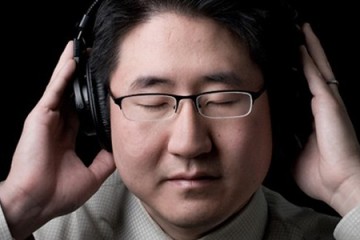Don't get Monica Lopez-Gonzalez started on filmmaker Baz Luhrman's The Great Gatsby.

Image caption: Christen Cromwell in Monica Lopez-Gonzalez' "Moments"
For the past three years, the Johns Hopkins alumna and adjunct faculty member has been a postdoctoral fellow in the Johns Hopkins School of Medicine's Department of Otolaryngology, where she studies the cognitive neuroscience of creativity alongside Dr. Charles Limb. She's also a musician and photographer/filmmaker, and what she does in the lab informs what she does as an artist and vice versa.
Lopez-Gonzalez heard an interview with Luhrman in which he talked about wanting the music and image to interact in the movie, which made both the artist and scientist parts of her brain curious. When she saw the movie, she was taken aback at how dramatically the image and music didn't complement one another. Music, as it so often does in movies, became merely the expressive cue, the sound that conveyed the emotional content that the images lacked. "Because of your image you want the music to take over and convey what you're trying to say," she says, the disappointment in her voice unmistakable.
"I think filmmakers sometimes think the audience is stupid and I think the audience is really smart," she continues, adding that she recently re-watched some of the movies of John Cassavetes as a palate cleanser. "He was all about understanding emotions. He's such a psychologist. If there's any director I can think of who I would say is a cognitive scientist too, it's him—just in terms of nailing the nuances and different perspectives of the emotional arc of the beautiful continuum of how we can express ourselves. So I was really inspired by him—I have a long way to go to be as good as him—but this is my first attempt doing this type of thing."
She's talking about Moments, the roughly 40-minute-long, black-and-white movie she made that debuts this weekend at Baltimore's annual Artscape festival. The movie is a nearly silent, black-and-white collection of short films about the six universal emotions that Lopez-Gonzalez wrote, shot, and edited in June using a pair of local theater actors—Christen Cromwell, a Johns Hopkins alumnus, and Andrew Porter. The soundtrack for the movie will be provided by a jazz trio of Peabody graduate students and alumni—saxophonist Adam Corson, pianist César Orozco, and bassist Jonathan Guo—who will improvise the score for the first time that night. Moments screens for free on Sunday at 7 p.m. in Falvey Hall of MICA's Brown Center.
For Lopez-Gonzalez, Moments is an experiment, and, in some ways, an extension of her cognitive science research. "I'm really interested in the role of emotion in music, in what happens when you give musicians an emotional cue and they start composing," she says, explaining her research studies the neuroscience of jazz musicians' brains while they are in the process of improvising. For the experiments, she created short film clips of human faces expressing one of the universal emotions: happiness, sadness, fear, surprise, anger, and disgust. Musicians watch the clips and then improvise.
The artist side of her brain kept speaking up during the experiments, however. "In the lab one has to constrain and control everything," she says. "So the film clips I use as my stimuli, they are one-minute segments, supercontrolled. The actress is sitting at a table, reads a letter or receives a text and responds. I don't play with camera, I don't play with lighting, I don't play with anything. And for science purposes, the point is the actress expressing emotion, not how does light affect it, how does color affect it, how does story affect it. But the artist in me knows that in a movie light does affect emotion, angle does affect it, all that stuff. So how can I make this more fun?"
Lopez-Gonzalez wrote the script and planned her shot sequences, creating a storyline but allowing space for the actors to improvise within the narrative framework. Most scenes take place in a single long take, and movement happens within the frame instead of editing shots together to suggest movement and space. She then had her three musicians watch the movie once with her to get a sense of timing, to know where they're heading but not how they're going to get there. And while there is no sheet music score, the movie itself is taking that place. Each musician will have a screen synced to the movie being projected to follow along as they watch, listen, and create in the moment.
As an experiment in cinematic viewing, Moments is both a throwback and contemporary. Lopez-Gonzalez has basically made a silent movie that will be accompanied by an in-theater band, much in the way early movies were screened in kino houses with piano accompaniment prior to the talkies. But unlike how, say, a contemporary ensemble like the Ally Orchestra creates new soundtracks for silent films in the public domain, Lopez-Gonzalez has made a contemporary silent movie and wants her musicians to respond to the film musically while watching it. Each time the movie screens, a different group could score it and produce a different movie experience. In fact, the same musicians could score it a week later and the results could be radically different. It's a movie that is forever unfinished until its score is made while an audience watches it, a kind of cinematic riff on Julio Cortazar's "counter-novel" Hopscotch.
"Emotions have an arc," Lopez-Gonzalez says. "I'm trying to make explicit how I understand emotions when language is not involved. I think all artists do this. Let me sit back and see how I see the world and [think about] how somebody else sees the world. And the universal emotions, these are the six that no matter where you come from in the world, you have the same set of facial features or body language, so everybody can understand them. So how do I pick up on these cues and how do I represent this on film so that people who are watching it for the first time can identify with it and the musicians can identify it? And then the musicians have to translate it into their language."
She realizes it's a lot to ask of the audience, to watch a movie that only becomes complete in the act of watching it. But given how sophisticated our visual vocabularies and understanding are today, it's also very rare that a movie can offer something resembling a new experience. The visual language of televisual media is so highly codified that certain image and sounds combinations are almost guaranteed to produce a desired reaction—there's a reason "tug at the heartstrings" is such a cliché. Add a sad violin to any image and you feel a little melancholic. Moments invites you to respond to something for the first time, and it very well may be a little weird.
"People will either like my thing or they'll hate it," Lopez-Gonzalez says and laughs. "Either one is fine. In the end it becomes a work all of us take part in. The film isn't done yet. It'll be finished on the 21st."
Posted in Arts+Culture, Science+Technology
Tagged music, charles limb, otolaryngology, film, jazz









